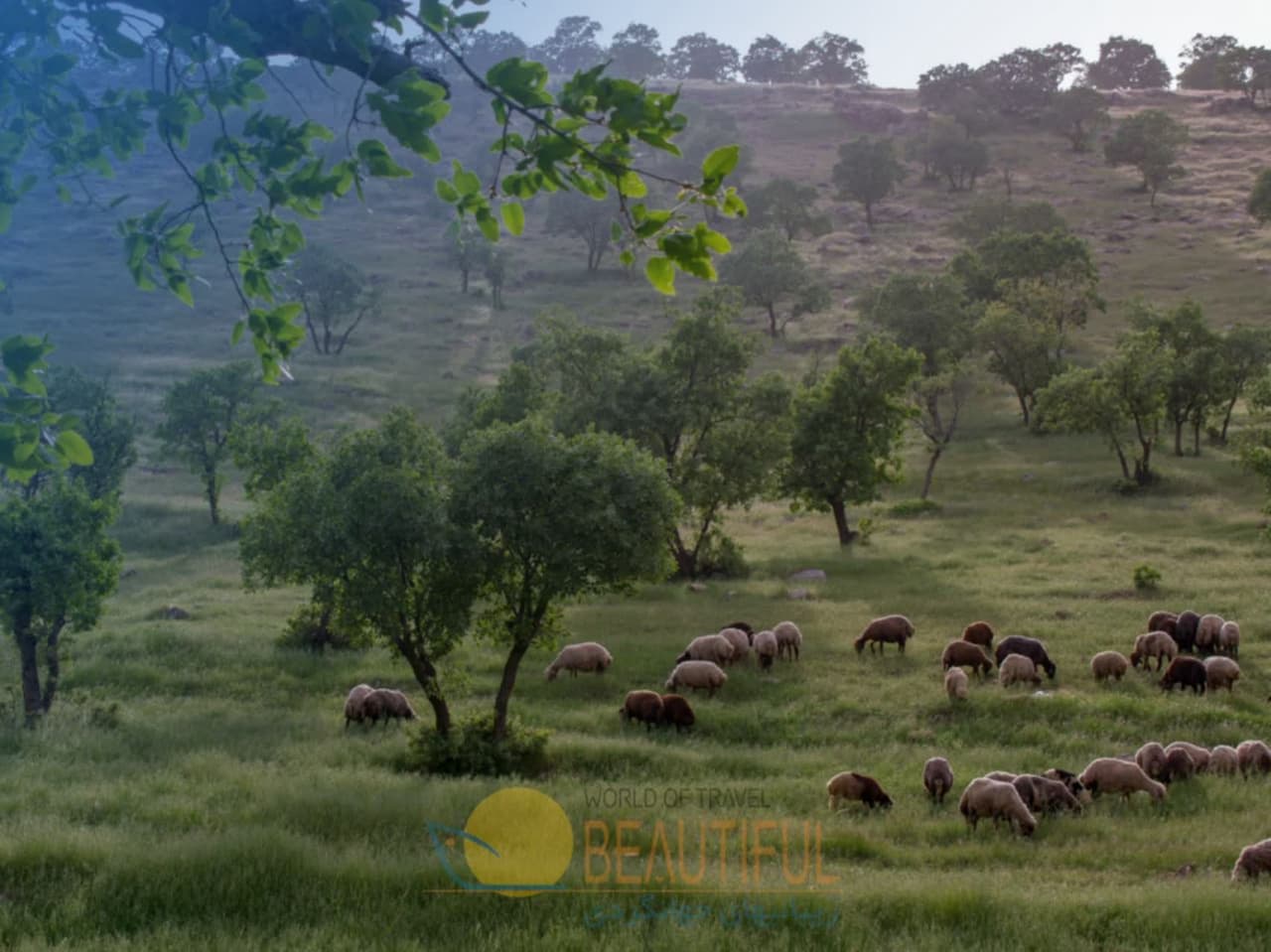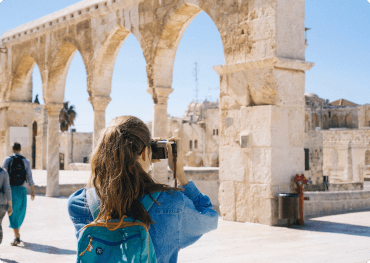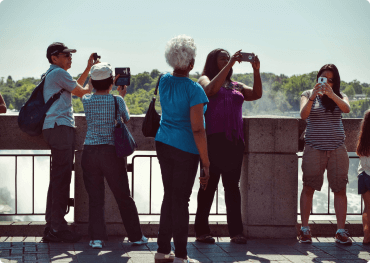
CU-108
Package Details
Day 1: Tehran
Arrivals at Tehran and assist at airport and then transfer to Hotel.
After breakfast half day Tehran city tour to visit Carpet Museum, Glass and Ceramic Museum.
Evening transfer to domestic airport and flight to Ahwaz.
O/N: Ahwaz.
Carpet Museum of Iran exhibits a variety of Persian carpets from all over Iran, dating from the 16th century to the present.
The museum's exhibition hall occupies 3,400 square meters (10,200 ft²) and its library contains 7,000 books.
The museum was designed by the last Queen of Iran, Farah Diba Pahlavi. The perforated structure around the museum's exterior is designed both to resemble a carpet loom, and to cast shade on the exterior walls, reducing the impact of the hot summer sun on the interior temperature.
Glassware and Ceramic Museum:is one of the museums in Tehran is. This historic house built in Qajar era and in Tehran. Avenue C bar is located. The effect on 7 Persian date Ordibehesht 1377 with registration number 2014 as one of the national monuments has been registered. Museum of Glass Museum of Glass and pottery.
This sets up 1330 home and work Qvamalsltnh and then for seven years was in the hands of the Egyptian Embassy. Then, to the Embassy of Afghanistan, Bank of Commerce, in 1355 with the cooperation of Iranian and Austrian engineers began to change.
Day 2: Ahwaz - Dezful
After breakfast, drive to Shushtar (97 km), visit old water mills and then trip to Shush (84 km), visit
Choghazanbil (2nd millennium BC), Denial holy shrine, Apadana Palace (546 BC) and
Shush museum. Continue to Dezful.
O/N: Dezful.
Shushtar also Romanized as Shūshtar and Shūstar, and Shooshtar is a city in and the capital of Shushtar County, Khuzestan Province, Iran. At the 2012 census, its population was 192,361.
Shushtar is an ancient fortress city, approximately 92 kilometres (57 mi) away from Ahvaz, the centre of the province. Much of its past agricultural productivity derives from the Roman-built irrigation system which centered on the Band-e Kaisar, the first dam bridge in Iran. The Mayor of Shushtar is Ahmad Asefi.
Chogha Zanbil is an ancient Elamite complex in the Khuzestan province of Iran. It is one of the few existent ziggurats outside of Mesopotamia. It lies approximately 42 km (26 mi) south-southeast of Dezful, 30 km (19 mi) south-east of Susa and 80 km (50 mi) north of Ahvaz.
The main building materials in Chogha Zanbil were mud bricks and occasionally baked bricks. The monuments were decorated with glazed baked bricks, gypsum and ornaments of faïence and glass. Ornamenting the most important buildings were thousands of baked bricks bearing inscriptions with Elamite cuneiform characters were all inscribed by hand. Glazed terracotta statues such as bulls and winged griffins guarded the entrances to the ziggurat. Near the temples of Kiririsha and Hishmitik-Ruhuratir, kilns were found that were probably used for the production of baked bricks and decorative materials. It is believed that the ziggurat was built in two stages. It took its multi-layered form in the second phase.
The ziggurat is considered to be the best preserved example in the world. In 1979, Chogha Zanbil became the first Iranian site to be inscribed on the UNESCO World Heritage List.
The Tomb of Daniel is the traditional burial place of the biblical prophet Daniel. Various locations have been named for the site, but the tomb in Susa, Iran, is the most widely accepted, it being first mentioned by Benjamin of Tudela, who visited Asia between 1160 and 1163.
Apadana Palace Winter Palace Achaemenid kings were. The palace on the orders of Darius king of the Achaemenid in the early 515_521 BC in Susa (ancient city) and the remains of the Elamite was founded. House walls of bricks and columns made of stone.
The area of the hall or Apadana Palace 10434 meters. The House called the court or Padanh by Artaxerxes II was rebuilt.
Haft Tapeh an archaeological site in the province about 15 kilometers southeast of the city of Susa is located and a series of hills Bastani, probably in Tekken or Kabnak of Elam civilization has the place itself. The extent of the archaeological site far attracted the attention of various explorers located.
According to the city as an important center of political theories during the reign of the kingdom of Elam and Tptyahr in the prior fifteen centuries AD after the destruction of it, the city of Susa was mentioned that the center of power conversion by Nyamdhast Shdhast, Although strong evidence to support it.
Day 3: Dezful - Khoram Abad
Early morning drive to Khoram Abad (184 km), visit Falak-ol Aflak Castle, Baba Taher Tomb.
O/N: Khorram Abad.
Falak-ol-Aflak Castle is a castle situated on the top of a large hill with the same name within the city of Khorram Abad, the regional capital of Lorestan province, Iran. This gigantic structure was built during the Sassanid era (226–651).
The Khoram Abad River runs past the eastern and south-western side of the Falak-ol-Aflak hill providing the fortress some natural protection on those sides. Today, the western and northern sides of the hill are bordered by the residential districts of Khorram Abad.
Falak-ol-Aflak castle is amongst the most important structures built during the Sassanid era. It has been known by a number of names since it was built over 1800 years ago. Recorded names have referred to it as Shapur-Khast or Sabr-Khast fortress, Dezbaz, Khoramabad castle, and ultimately the Falak-ol-Aflak Castle.
The tomb of Baba Taher Khorramabad one of the monuments and cultural city of Khorramabad is. Apparently Baba poet famous Iranian, Lors and residents of Khorram abad, respectively. Babataher in Lori dialect pronunciation are Bavtahr. In the works and couplet of the poet of Persian words and expressions Larry is used. Many years ago there was an inscription wooden Inside the building the tree person buried with verses written on it and in it he called "Baba Taher" remember is. Ata Hassanpour, one of the archaeologists and heritage experts Lorestan Province explained in Lorestan nicknamed "Baba" is used for those who are right and that's probably the tomb of Baba Taher is in Khorram abad, one of the It belongs to the people, but definitely not this person the Hamadan Baba naked, because the tomb dates back to the Safavid era is in Khorram abad.
Day 4: Khoram Abad - Kermanshah
After breakfast, drive to Kermanshah (189 km), visit Tekye Moavenolmolk and Bazaar.
O/N: Kermanshah.
Tekye Moavenolmolk such beautiful and magnificent works from the period of Qajar in Kermanshah has remained. The monument in the old city of Kermanshah in Absheron district of the Old and in the streets.
Reliance Solar became operational in 1282 and at that time in order to rituals and religious ceremonies and ethnic disputes and tribal went to work.
Day 5: Kermanshah – Hamadan
After breakfast visit Tagh Bostan (450 AD) and then drive to Hamadan (184 km), on the way
Visiting Bisotun (480 BC), and Anahita Temple, continue to Hamadan. In Hamadan visit
Baba Taher Tomb.
O/N: Hamadan.
Taq-e Bostan is a site with a series of large rock reliefs from the era of Sassanid Empire of Persia, the Iranian dynasty which ruled western Asia from 226 to 650 AD. This example of Sassanid art is located 5 km from the city center of Kermanshah in western Iran. It is located in the heart of the Zagros Mountains, where it has endured almost 1,700 years of wind and rain. Originally, several sources were visible next to and below the reliefs and arches, some of which are now covered. Sources next to the reliefs still feed a large basin in front of the rock. The site has been turned into an archaeological park and a series of late Sasanian and Islamic column capitals have been brought together
The Taq-e Bostan complex comprise a rock relief standing on its own and several more reliefs associated with two rock cut arches. They illustrate the investiture ceremonies of Ardashir II, Shapur II, Shapur III and Khosrau II. They also depict the hunting scenes of Khosrau II.
The Bisotun is a multilingual inscription and large rock relief on a cliff at Mount Behistun in the Kermanshah Province of Iran, near the city of Kermanshah in western Iran. It was crucial to the decipherment of cuneiform script.
Authored by Darius the Great sometime between his coronation as king of the Persian Empire in the summer of 522 BC and his death in autumn of 486 BC, the inscription begins with a brief autobiography of Darius, including his ancestry and lineage. Later in the inscription, Darius provides a lengthy sequence of events following the deaths of Cyrus the Great and Cambyses II in which he fought nineteen battles in a period of one year (ending in December 521 BC) to put down multiple rebellions throughout the Persian Empire.
The inscription states in detail that the rebellions, which had resulted from the deaths of Cyrus the Great and his son Cambyses II, were orchestrated by several impostors and their co-conspirators in various cities throughout the empire, each of whom falsely proclaimed kinghood during the upheaval following Cyrus's death.
Temple of Anahita monument in the city today Kangavar is located. Kangavar in the middle of modern Hamadan, Kermanshah and the historical way Hegmataneh Ctesiphon is located. The building with an area of 6.4 hectares, on a rocky ridge overlooking the plain Gngavr was created. Anahita, the angel and the guardian of water and an abundance of beauty and fertility among Iranians has been the official and dignity. "It remains a magnificent temple is the largest stone buildings in Building 209 at 244 meters Foursquare rectangular in size over the low-lying bed of silica volcanic rocks in Kermanshah Province is located in the city Kangavar. Anahita temple, like the tall buildings built from scaffolding practices (the account of) Iran Bob was in the plains and subsequent periods is also important monuments, temples and some government buildings have been built on the platform. Over this monument was erected a row of stone columns that the height of each column is 54/2 meters. Verdi according to a two-way staircase built on the southern side and in front of the northeast stairs one-way access road to the site has made it possible.
Forty Maran quarry is located 2 km west of the building and is now cutting the pillar stones and stone facade at the same time remain mine. The building dates back to the period of the Parthian and Sassanid attributed, symbols and words carved on the rocks Grdydhast Sassanid era.
Mausoleum of Baba Taher: Babataher that around the end of the fourth century and early fifth century lived, his time is of great poets and mystics. More time passed his life in poverty. He is one of the most famous Iranian poets of that time failed two-bit bit of passion and motivation that is written with an accent Laki language of the robbed. Of couplets Baba Taher In addition, other literary works remains such that it can be divided into two pieces, a few poems, a collection of aphorisms Arabic and the book finally be mentioned. Baba Taher collection of aphorisms in Arabic, his mystical beliefs and worship and ecstasy and love of knowledge and noting stated that the mystic consisted of 420 subjects fifty Bob and together with the end of misc. His last book consists of two parts. The first part is a treatise on the beliefs of mystics and Sufis with aphorisms and second part of the essay is called (Futuh al-Hamdani Alrbany fi references) as if it Commentator Johnny Bic Hamedan. In the inner courtyard of the tomb 24-bit on 24 beautiful piece of stone carved in the lower part of the inner courtyard of Mazar-installed. In addition to his two literary works is another bit of Baba left that can be divided into two pieces and several poems and a book entitled "Finally," noted.
Day 6: Hamadan
After breakfast, drive to Alisadr Cave, afternoon return to Hamadan.
O/N: Hamadan.
The Ali Sadr Cave originally called Ali Saadr or Ali Saard (meaning cold) is the world's largest water cave which attracts thousands of visitors every year. It is located in Ali Sadr Kabudarahang County about 100 kilometers north of Hamadan, western Iran (more accurately at 48°18'E 35°18'N). Because of the cave's proximity to large cities such as Hamadan, it is a highly recommended destination for tourists from all corners of the world. Tours of the cave are available by pedalos.
Alisadr is the world's biggest water cave, where you sit in a boat and watch the view. This cave is located at 48°18'E 35°18'N, in the southern part of Ali Sadr village. The cave is entered at the side of a hill called Sari Ghiyeh which also includes two other caves called Sarab and Soubashi, each 7 and 11 kilometers from Ali Sadr Cave. Apparently, the water in Ali Sadr cave stems from a spring in Sarab.
Day 7: Hamadan - Kashan
After breakfast, check out hotel and drive to Kashan (400 km), via Gugad Citadel, continues to Kasahn.
In Kashan visit Fin garden.
O/N: Kashan.
The Gouged stronghold is located in the city of Gouged, in the Golpayegan, in Iran. The city Gouged is located 5 km to the north of Golpayegan. In the peace time, the stronghold was used as a caravansary, but during the war time or when the bandits attacked, it was used as a castle. This structure is located in the Golpayegani alley and Ghale alley. At present, the stronghold is used as a traditional three star hotel.The Gouged stronghold is one of the biggest adobe and mud structure in Iran. It was built approximately 400 years ago. The only document related to this structure dates back to 140 years ago. By this document, Ali Khan Bakhtiari gave half of the stronghold to his wife as mahr.
Fin Garden, or Bagh-e Fin, located in Kashan, Iran, is a historical Persian garden. It contains Kashan's Fin Bath, where Amir Kabir, the Qajarid chancellor, was murdered by an assassin sent by King Nasereddin Shah in 1852. Completed in 1590, the Fin Garden is the oldest extant garden in Iran.
The origins of the garden may be anterior to the Safavid period; some sources indicate that the garden has been relocated from another place, but no clear picture of it has been found.
Day 8: Kashan - Isfahan
After breakfast, visit Brougerdi and Tabatabai old houses, Sultan Amir Ahamad (old bath) and Aghabozorg Mosque
Then drive to Isfahan (218 km). On the way Visit Abyaneh Village.
O/N: Isfahan.
The Tabātabāei House is a historic house in Kashan, Iran. It was built in the early 1880 s for the affluent Tabatabaei family.
The house is almost 5,000 square meters and has been very well renovated. The interior yards have beautiful gardens. The house has 40 rooms 4 courtyards, 4 basements 3 wind wards.
Home Borujerdian the historic city of Kashan is. The building is located in the neighborhood Sultan Mir Ahmad and in the second half of the 13th century Hijri built in Qajar era and was registered under the number 1083 in the national index. The house has a beautiful crescent-shaped symmetrical vents on the roof of the hall and pergola on one of the most beautiful manifestations of Persian architecture to display it. So that the inscriptions on all four sides of the hall, the building dates back to 1292 BC E..
Sultan Amir Ahmad Bathhouse, Hammam-e Sultan Amir Ahmad, also known as the Qasemi Bathhouse, is a traditional Iranian public bathhouse in Kashan, Iran. It was constructed in the 16th century, during the Safavid era; however, the bathhouse was damaged in 1778 as a result of an earthquake and was renovated during the Qajar era. The bathhouse is named after Imamzadeh Sultan Amir Ahmad, whose mausoleum is nearby.
Agha Bozorg Mosque is a historical mosque in Kashan, Iran. The mosque was built in the late 18th century by master-mimar Ustad Haj Sa'ban-ali.
The mosque has been described as "the finest Islamic complex in Kashan and one of the best of the mid-19th century. Noted for its symmetrical design, it consists of two large iwans, one in front of the mihrab and the other by the entrance. The courtyard has a second court in the middle which comprises a garden with trees and a fountain.
Abyaneh is a village in Barzrud Rural District, in the Central District of Natanz County, Isfahan Province, Iran. At the 2006 census.
Characterized by a peculiar reddish hue, the village is one of the oldest in Iran, attracting numerous native and foreign tourists year-round, especially during traditional feasts and ceremonies.
An Abyanaki woman typically wears a white long scarf (covering the shoulders and upper trunk) which has a colourful pattern and an under-knee skirt. Abyanaki people have persistently maintained this traditional costume.On top of the village sits the ruins of a Sasanid era fort.
The dialect of the people of Abyaneh has preserved some characteristics of the Middle Persian language, the language of the Sassanian Persia.
Day 9: Isfahan
Full day Isfahan city tour to visit Naghshe Jahan Sq Include Imam and Sheikh Lotfolah Mosque, Ali Qapu,
Bazaar. Evening visit old bridges (Si-o-She Pol & Khaju Bridge), Zoor Khane (Traditional Iranian sport place).
O/N: Isfahan.
Naqsh-e Jahan Square, known as Imam Square, formerly known as Shah Square, is a square situated at the center of Isfahan city, Iran. Constructed between 1598 and 1629, it is now an important historical site, and one of UNESCO's World Heritage Sites. It is 160 metres (520 ft) wide by 560 metres (1,840 ft) long (an area of 89,600 square metres (964,000 sq ft)). The square is surrounded by buildings from the Safavid era. The Shah Mosque is situated on the south side of this square. On the west side is the Ali Qapu Palace. Sheikh Lotf Allah Mosque is situated on the eastern side of this square and at the northern side Keisaria gate opens into the Isfahan Grand Bazaar. Today, Namaaz-e Jom'eh (the Muslim Friday prayer) is held in the Shah Mosque.The square is depicted on the reverse of the Iranian 20,000 rials banknote.
The Lotfollah Mosque : The Lotfollah Mosque had a secret entrance that spanned underneath the Maidan, from the Palace on the opposite side of the square.
Of the four monuments that dominated the perimeter of the Naqsh-e Jahan square, the Lotfollah Mosque, opposite the palace, was the first to be built. The purpose of this mosque was for it to be a private mosque of the royal court, unlike the Shah mosque|Masjed-e Shah, which was meant for the public. For this reason, the mosque does not have any minarets and is of a smaller size. Indeed, few Westerners at the time of the Safavids even paid any attention to this mosque, and they certainly did not have access to it. It wasn't until centuries later, when the doors were opened to the public, that ordinary people could admire the effort that Shah Abbas had put into making this a sacred place for the ladies of his harem, and the exquisite tile-work, which is far superior to those covering the Shah Mosque.
Ali Qapu is in effect but a pavilion that marks the entrance to the vast royal residential quarter of the Safavid Isfahan which stretched from the Maidan Naqsh-i-Jahan to the Chahar Bagh Boulevard. The name is made of two elements: "Ali", Arabic for exalted, and "Qapu" Turkic for portal or royal threshold. The compound stands for "Exalted Porte". This name was chosen by the Safavids to rival the Ottomans' celebrated name for their court : Bab-i Ali, or the "Sublime Porte"). It was here that the great monarch used to entertain noble visitors, and foreign ambassadors.
Shah Abbas, here for the first time celebrated the Nowruz (New Year's Day) of 1006 AH / 1597 A.D. A large and massive rectangular structure, the Ali Qapu is 48 m (157 ft) high and has six floors, fronted with a wide terrace whose ceiling is inlaid and supported by wooden columns.
On the sixth floor, the royal reception and banquets were held. The largest rooms are found on this floor. The stucco decoration of the banquet hall abounds in motif of various vessels and cups. The sixth floor was popularly called (the music room) as it was here that various ensembles performed music and sang songs. From the upper galleries, the Safavid ruler watched polo games, maneuvers and horse-racing below in the Naqsh-i-Jahan square.
Allāhverdi Khan Bridge, popularly known as Si-o-seh pol “The bridge of thirty-three spans” is one of the eleven bridges of Isfahan, Iran and the longest bridge on Zayandeh River with the total length of 297.76 metres (976.9 ft). It is highly ranked as being one of the most famous examples of Safavid bridge design.
It was constructed by the finance and the inspection of Allahverdi Khan Undiladze chancellor of Shah Abbas I, an ethnic Georgian, it consists of two rows of 33 arches from either sides, left and right.
There is a larger base plank at the start of the bridge where the Zayandeh River flows under it, supporting a tea house which nowadays is abandoned due to the shortage of water and the river drought.
Khaju Bridge is a bridge in the province of Isfahan, Iran, which has been described as the finest in the province. It was built by the Persian Safavid king, Shah Abbas II around 1650, on the foundations of an older bridge.
Serving as both a bridge, and a dam (or a weir), it links the Khaju quarter on the north bank with the Zoroastrian quarter across the Zayandeh River.
Although architecturally functioning as a bridge and a weir, it also served a primary function as a buildingand a place for public meetings. This structure was originally decorated with artistic tilework and paintings, and served as a teahouse.
Sport builds or ancient sport or sport athletic movements set up sports with toys and Byasbab and customs related to their history and culture within Iran have been prevalent from ancient times. Sports Other Sports Zurkhaneh name of the ancient Persians. Where the ancient sport engaged gymnasium is also a gymnasium in addition to wrestling as sport builds up. World Zurkhaneh rituals record of athletic and heroic efforts and Zurkhaneh Sports Federation Iran in cooperation with the Cultural Heritage, Handicrafts and Tourism Organizationwere prepared. Zurkhaneh rituals and athletic on 25 Persian date Aban 1389 of 16 November 2010 on the list of Intangible Heritage of UNESCO by Iran was a world record.
Day: 10 Isfahan
Full day city tour to visit Hasht Behesht , Chehel Sotoon Palace, Vank Cathedral, Jame mosque and
Shaking Minarets.
O/N: Isfahan.
Hasht Behesht, meaning "Eight Paradises" is a Safavid era palace in Isfahan.
It was built in 1669 and is today protected by Iran's Cultural Heritage Organization. Of more than forty mansions which existed in Isfahan during the rule of Safavids, this is the only one left today.
Chehel Sotoun ( “Forty Columns”) is a pavilion in the middle of a park at the far end of a long pool, in Isfahan, Iran, built by Shah Abbas II to be used for his entertainment and receptions. In this palace, Shah Abbas II and his successors would receive dignitaries and ambassadors, either on the terrace or in one of the stately reception halls.
The name, meaning "Forty Columns" in Persian, was inspired by the twenty slender wooden columns supporting the entrance pavilion, which, when reflected in the waters of the fountain, are said to appear to be forty.
As with Ali Qapu, the palace contains many frescoes and paintings on ceramic. Many of the ceramic panels have been dispersed and are now in the possession of major museums in the west. They depict specific historical scenes such as the infamous Battle of Chaldiran against the Ottoman Sultan Selim I, the reception of an Uzbek King in 1646, when the palace had just been completed; the welcome extended to the Mughal Emperor, Humayun who took refuge in Iran in 1544; the battle of Taher-Abad in 1510 where the Safavid Shah Ismail I vanquished and killed the Uzbek King. A more recent painting depicts Nader Shah's victory against the Indian Army at Karnal in 1739. There are also less historical, but even more aesthetic compositions in the traditional miniature style which celebrate the joy of life and love.
The Chehel Sotoun Palace is among the 9 Iranian Gardens which are collectively registered as one of the Iran’s 17 registered World Heritage Sites under the name of the Persian Garden.
Holy Savior Cathedral is a cathedral located in the New Julfa district of Isfahan, Iran. It is commonly referred to as the Vank (Վանք), which means "monastery" or "convent" in Armenian language.
The cathedral was established in 1606, dedicated to the hundreds of thousands of Armenian deportees that were resettled by Shah Abbas I during the Ottoman War of 1603-1618.
The varying fortunes and independence of this suburb across the Zayande River and its eclectic mix of European missionaries, mercenaries and travelers can be traced almost chronologically in the cathedral's combination of building styles and contrasts in its external and internal architectural treatment.
The Jāmeh Mosque of Isfahān is the grand, congregational mosque (Jāmeh) of Isfahān city, within Isfahān Province, Iran. The mosque is the result of continual construction, reconstruction, additions and renovations on the site from around 771 to the end of the 20th century. The Grand Bazaar of Isfahan can be found towards the southwest wing of the mosque. It is a UNESCO World Heritage Site since 2012.
This is one of the oldest mosques still standing in Iran, and it was built in the four-iwan architectural style, placing four gates face to face. An iwan is a vaulted open room. The qibla iwan on the southern side of the mosque was vaulted with muqarnas during the 13th century. Muqarnas are niche-like cells.
Monarjonban of one of the city's history Aref called " Uncle Abdullah Karladany " it was buried. The remarkable thing about this monument is that by moving a minaret , minarets also comes to movement and mobility should be noted that each have a width of nine meters tall minarets are seventeen yards. Uncle Abdullah historic stone written over 716 AH shows that in the period of Öljaitü Aylkhan is Muslim.
In Iran, some minarets have the ability to shake the so-called Monarjonban say to them. Iran is one of the most Mnarjnbanhay in Isfahan and another in the city of Ardakan and are located in the Khranq.
Details
Pellentesque accumsan magna in augue sagittis, non fringilla eros molestie. Sed feugiat mi nec ex vehicula, nec vestibulum orci semper. Class aptent taciti sociosqu ad litora torquent per conubia nostra, per inceptos himenaeos. Donec tristique commodo fringilla. Duis aliquet varius mauris eget rutrum. Nullam sit amet justo consequat, bibendum orci in, convallis enim. Proin convallis neque viverra finibus cursus. Mauris lacinia lacinia erat in finibus.
Pellentesque accumsan magna in augue sagittis, non fringilla eros molestie. Sed feugiat mi nec ex vehicula, nec vestibulum orci semper. Class aptent taciti sociosqu ad litora torquent per conubia nostra, per inceptos himenaeos. Donec tristique commodo fringilla.
- Specilaized Bilingual Guide
- Private Transport
- Entrance Fees
- Box Lunch,Water,Dinner and Snacks
Pellentesque accumsan magna in augue sagittis, non fringilla eros molestie. Sed feugiat mi nec ex vehicula, nec vestibulum orci semper. Class aptent taciti sociosqu ad litora torquent per conubia nostra, per inceptos himenaeos. Donec tristique commodo fringilla.
- Specilaized Bilingual Guide
- Private Transport
- Entrance Fees
- Box Lunch,Water,Dinner and Snacks
Pellentesque accumsan magna in augue sagittis, non fringilla eros molestie. Sed feugiat mi nec ex vehicula, nec vestibulum orci semper. Class aptent taciti sociosqu ad litora torquent per conubia nostra, per inceptos himenaeos. Donec tristique commodo fringilla.
- Specilaized Bilingual Guide
- Private Transport
- Entrance Fees
- Box Lunch,Water,Dinner and Snacks
Pellentesque accumsan magna in augue sagittis, non fringilla eros molestie. Sed feugiat mi nec ex vehicula, nec vestibulum orci semper. Class aptent taciti sociosqu ad litora torquent per conubia nostra, per inceptos himenaeos. Donec tristique commodo fringilla.
- Specilaized Bilingual Guide
- Private Transport
- Entrance Fees
- Box Lunch,Water,Dinner and Snacks
Pellentesque accumsan magna in augue sagittis, non fringilla eros molestie. Sed feugiat mi nec ex vehicula, nec vestibulum orci semper. Class aptent taciti sociosqu ad litora torquent per conubia nostra, per inceptos himenaeos. Donec tristique commodo fringilla.
- Specilaized Bilingual Guide
- Private Transport
- Entrance Fees
- Box Lunch,Water,Dinner and Snacks






















